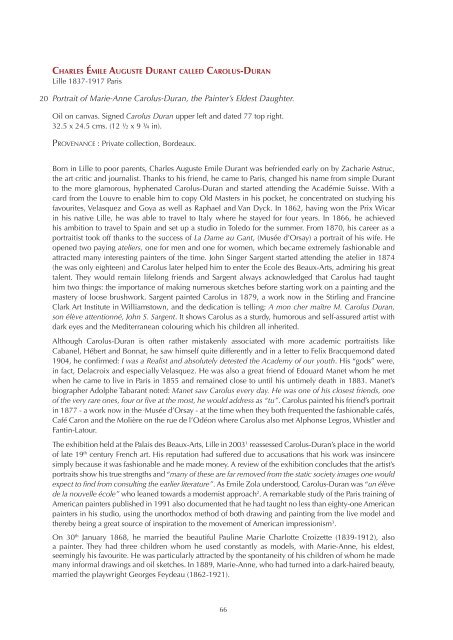Catalogue-2014-Jean-Luc-Baroni
- No tags were found...
Create successful ePaper yourself
Turn your PDF publications into a flip-book with our unique Google optimized e-Paper software.
Charles Émile Auguste Durant called Carolus-Duran<br />
Lille 1837-1917 Paris<br />
20 Portrait of Marie-Anne Carolus-Duran, the Painter’s Eldest Daughter.<br />
Oil on canvas. Signed Carolus Duran upper left and dated 77 top right.<br />
32.5 x 24.5 cms. (12 ½ x 9 ¾ in).<br />
Provenance : Private collection, Bordeaux.<br />
Born in Lille to poor parents, Charles Auguste Emile Durant was befriended early on by Zacharie Astruc,<br />
the art critic and journalist. Thanks to his friend, he came to Paris, changed his name from simple Durant<br />
to the more glamorous, hyphenated Carolus-Duran and started attending the Académie Suisse. With a<br />
card from the Louvre to enable him to copy Old Masters in his pocket, he concentrated on studying his<br />
favourites, Velasquez and Goya as well as Raphael and Van Dyck. In 1862, having won the Prix Wicar<br />
in his native Lille, he was able to travel to Italy where he stayed for four years. In 1866, he achieved<br />
his ambition to travel to Spain and set up a studio in Toledo for the summer. From 1870, his career as a<br />
portraitist took off thanks to the success of La Dame au Gant, (Musée d’Orsay) a portrait of his wife. He<br />
opened two paying ateliers, one for men and one for women, which became extremely fashionable and<br />
attracted many interesting painters of the time. John Singer Sargent started attending the atelier in 1874<br />
(he was only eighteen) and Carolus later helped him to enter the Ecole des Beaux-Arts, admiring his great<br />
talent. They would remain lifelong friends and Sargent always acknowledged that Carolus had taught<br />
him two things: the importance of making numerous sketches before starting work on a painting and the<br />
mastery of loose brushwork. Sargent painted Carolus in 1879, a work now in the Stirling and Francine<br />
Clark Art Institute in Williamstown, and the dedication is telling: A mon cher maître M. Carolus Duran,<br />
son élève attentionné, John S. Sargent. It shows Carolus as a sturdy, humorous and self-assured artist with<br />
dark eyes and the Mediterranean colouring which his children all inherited.<br />
Although Carolus-Duran is often rather mistakenly associated with more academic portraitists like<br />
Cabanel, Hébert and Bonnat, he saw himself quite differently and in a letter to Felix Bracquemond dated<br />
1904, he confirmed: I was a Realist and absolutely detested the Academy of our youth. His “gods” were,<br />
in fact, Delacroix and especially Velasquez. He was also a great friend of Edouard Manet whom he met<br />
when he came to live in Paris in 1855 and remained close to until his untimely death in 1883. Manet’s<br />
biographer Adolphe Tabarant noted: Manet saw Carolus every day. He was one of his closest friends, one<br />
of the very rare ones, four or five at the most, he would address as “tu”. Carolus painted his friend’s portrait<br />
in 1877 - a work now in the , Musée d’Orsay - at the time when they both frequented the fashionable cafés,<br />
Café Caron and the Molière on the rue de l’Odéon where Carolus also met Alphonse Legros, Whistler and<br />
Fantin-Latour.<br />
The exhibition held at the Palais des Beaux-Arts, Lille in 2003 1 reassessed Carolus-Duran’s place in the world<br />
of late 19 th century French art. His reputation had suffered due to accusations that his work was insincere<br />
simply because it was fashionable and he made money. A review of the exhibition concludes that the artist’s<br />
portraits show his true strengths and “many of these are far removed from the static society images one would<br />
expect to find from consulting the earlier literature”. As Emile Zola understood, Carolus-Duran was “un élève<br />
de la nouvelle école” who leaned towards a modernist approach 2 . A remarkable study of the Paris training of<br />
American painters published in 1991 also documented that he had taught no less than eighty-one American<br />
painters in his studio, using the unorthodox method of both drawing and painting from the live model and<br />
thereby being a great source of inspiration to the movement of American impressionism 3 .<br />
On 30 th January 1868, he married the beautiful Pauline Marie Charlotte Croizette (1839-1912), also<br />
a painter. They had three children whom he used constantly as models, with Marie-Anne, his eldest,<br />
seemingly his favourite. He was particularly attracted by the spontaneity of his children of whom he made<br />
many informal drawings and oil sketches. In 1889, Marie-Anne, who had turned into a dark-haired beauty,<br />
married the playwright Georges Feydeau (1862-1921).<br />
66
















